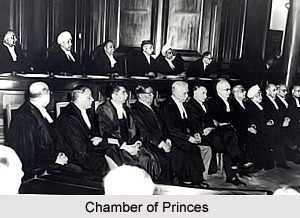 The Chamber of Princes was an organization that was established in the year 1920. It was formed through a royal proclamation of the King Emperor in order to provide a forum to the various rulers from the different princely states of India. The Indian princes could declare and demand their requirements and objectives to the British government of India. The Chamber of Princes existed under the end of the British dominion in the country in the year 1947. The Chamber of Princes was set up after the British administration abandoned their policy of isolating and segregating the Indian princes and kings from one another and also from the rest of the globe.
The Chamber of Princes was an organization that was established in the year 1920. It was formed through a royal proclamation of the King Emperor in order to provide a forum to the various rulers from the different princely states of India. The Indian princes could declare and demand their requirements and objectives to the British government of India. The Chamber of Princes existed under the end of the British dominion in the country in the year 1947. The Chamber of Princes was set up after the British administration abandoned their policy of isolating and segregating the Indian princes and kings from one another and also from the rest of the globe.
Members of Chamber of Princes
The first meeting of the Chamber of Princes was held in the year 1921 and originally consisted of around 120 members; and among them 108 members were from the significant princely states and were members in their own rights. The remaining 12 seats were reserved for the representatives of the rest of the 127 Indian princely states. Apart from these, there were 327 minor states as well those were not represented at the Chamber. Moreover, a few of the major Indian princes also refused to participate and join the Chamber of Princes. The Chamber of Princes generally held annual meetings for the various representatives of the princely states. The Viceroy of India presided the meeting but it also appointed a Standing Committee which held meetings at regular intervals. The Chancellor was an officer who was elected by the full Chamber. The Chancellor thus chaired the Standing Committee of the Chamber of Princes.
Resolution of Chamber of Princes
The Chamber that was established as an institution to provide a platform for the Indian rulers made a resolution on 12th March 1940. The Chamber of Princes recorded its insistent view that in future constitution for the country, the necessary assurance for safeguarding the autonomy and sovereignty of the various princely states and for the protection of the rights and interests of the Indian princes, which occurred from treaties and sanads or otherwise, should be successfully provided. It was also ensured that none of the princely states should not be able to dominate other states obstruct with the rights and protection assured to them. The members of the Chamber of Princes had their rights and voices pertaining the significance and historical position of the state and its ruler.
Chancellors of Chamber of Princes
The Chancellors of the Chamber of Princes who were elected by the members are mentioned below-
* Maharaja Ganga Singh of Bikaner (1921- 1926)
* Maharaja Adhiraj Bhupinder Singh of Patiala (1926- 1931)
* Maharaja K. S. Ranjitsinhji of Nawanagar (1931- 1937)
* Maharaja K. S. Digvijaysinhji of Nawanagar (1937- 1944)
* Nawab Hamidullah Khan of Bhopal (1944- 1947)



















